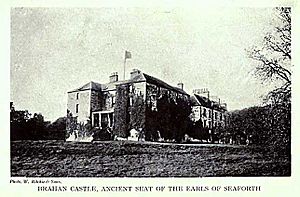Siege of Brahan facts for kids
Quick facts for kids Siege of Brahan |
|||||||
|---|---|---|---|---|---|---|---|
| Part of Jacobite rising of 1715 | |||||||
 Brahan Castle |
|||||||
|
|||||||
| Belligerents | |||||||
Clan Sutherland Clan Munro Clan Fraser of Lovat |
Clan Mackenzie |
||||||
| Commanders and leaders | |||||||
| Earl of Sutherland Baronet Munro Fraser of Castle Leathers |
Earl of Seaforth | ||||||
| Strength | |||||||
| 1500 | Unknown | ||||||
| Casualties and losses | |||||||
| Unknown | 400 cows seized 200 sheep seized |
||||||
The Siege of Brahan happened in Scotland in November 1715. It was an important part of the Jacobite rising of 1715. During this time, Scottish Highlanders who supported the British government surrounded Brahan Castle. This castle was the home of William Mackenzie, 5th Earl of Seaforth, who was a strong supporter of the Jacobites. The Jacobites wanted to bring the House of Stuart royal family back to the throne.
What Led to the Siege?
William Mackenzie, the 5th Earl of Seaforth, was a key supporter of the Jacobite cause in 1715. The Jacobite rebellion faced a setback at the Battle of Sheriffmuir on November 13, 1715. On the same day, Mackenzie's own forces had lost at the Siege of Inverness.
However, the government forces had another reason to attack Brahan Castle. Just a month before, Mackenzie had defeated them at the Skirmish of Alness. So, the Earl of Sutherland and Sir Robert Munro of Foulis, who led the siege, were looking for revenge.
After the Jacobites lost at Sheriffmuir, Mackenzie of Seaforth went back towards Inverness. He had left some soldiers there. But government forces had already taken the town. As Mackenzie got closer, about 850 government soldiers prepared to fight him. These soldiers came from different clans, including Clan Sutherland, Clan Mackay, Clan Grant, Clan Munro, and Clan Forbes.
Mackenzie avoided this fight and returned to Brahan Castle. His pursuers stopped at the Fraser's Castle Downie. Lady Seaforth tried to make a deal, promising her son would surrender. But he did not. Instead, he escaped to the Isle of Lewis and then to France.
The Siege Begins
Major James Fraser of Castle Leathers was a soldier who took part in the Siege of Brahan. He wrote about what happened.
After the government forces captured Inverness, the Earl of Sutherland and Sir Robert Munro arrived with their men. Lord Seaforth and many other clan members had returned home from Sheriffmuir. The Earl of Sutherland asked Lord Lovat for help, as he was worried about another attack from the Mackenzies.
Major Fraser was sent with 400 men to meet the Earl of Sutherland. That night, the Earl of Sutherland and the Munros wanted revenge for what the Mackenzies had done to them. They set up camp near Lord Seaforth's house. They destroyed what they could.
About 1500 men were camped there. One hundred Frasers and one hundred Munros were sent to find food. They brought back about 400 cows and 200 sheep from the mountains. There was plenty of food for everyone. After staying for two nights, they marched away, taking 300 cows with them.
What Happened Next?
Historian Peter Simpson explains that Colonel Munro (Sir Robert) became the governor of Inverness for a while. He and other soldiers made the rebel Mackenzies give up their weapons at Brahan. They turned Mackenzie of Seaforth's home into a military base for King George.
Munro, along with soldiers from the Grants, Rosses, and Mackays, forced the surrender of Mackenzie, Earl of Seaforth, at the Moor of Gilliecheriest.
In the months after the rebellion was defeated, the Jacobites slowly gave up their weapons. Lady Mackenzie of Seaforth wrote a letter to General Charles Cadogan in April 1716. She described what was happening at Brahan Castle:
She wrote that Colonel Brooks arrived with about 400 men, plus the soldiers already there. Colonel Munro's company was also going to stay at Brahan until all the Highlanders gave up their weapons. Lady Mackenzie felt it was unfair that she, as a widow, was being bothered so much. She believed the weapons could have been given up at Inverness instead of at her home. She had already sent many orders to her tenants to hand over their weapons quickly.
Images for kids




